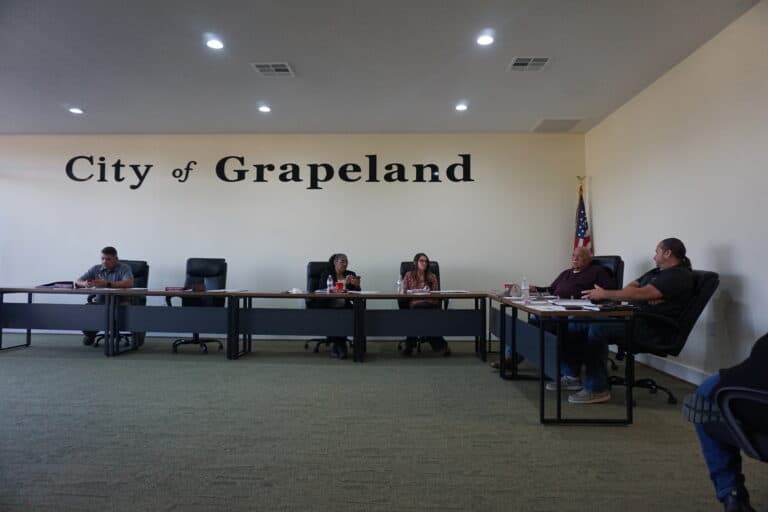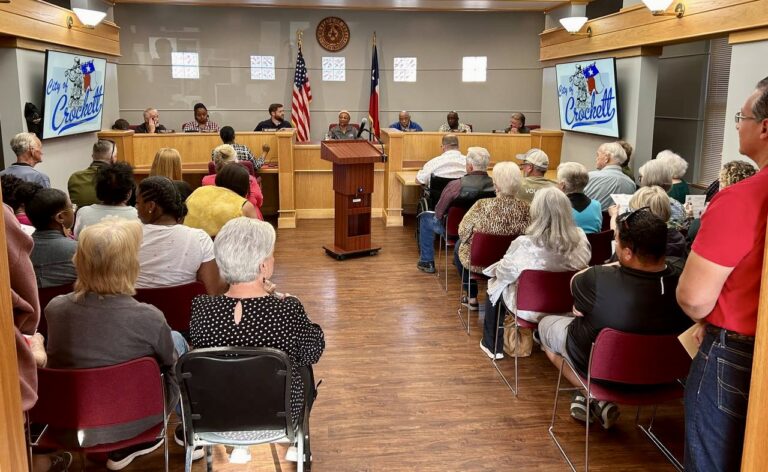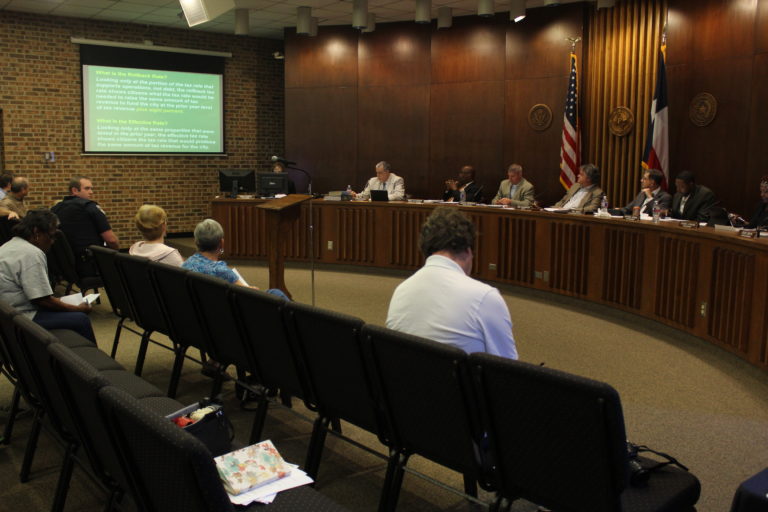A Day in the Life of a State Park Ranger
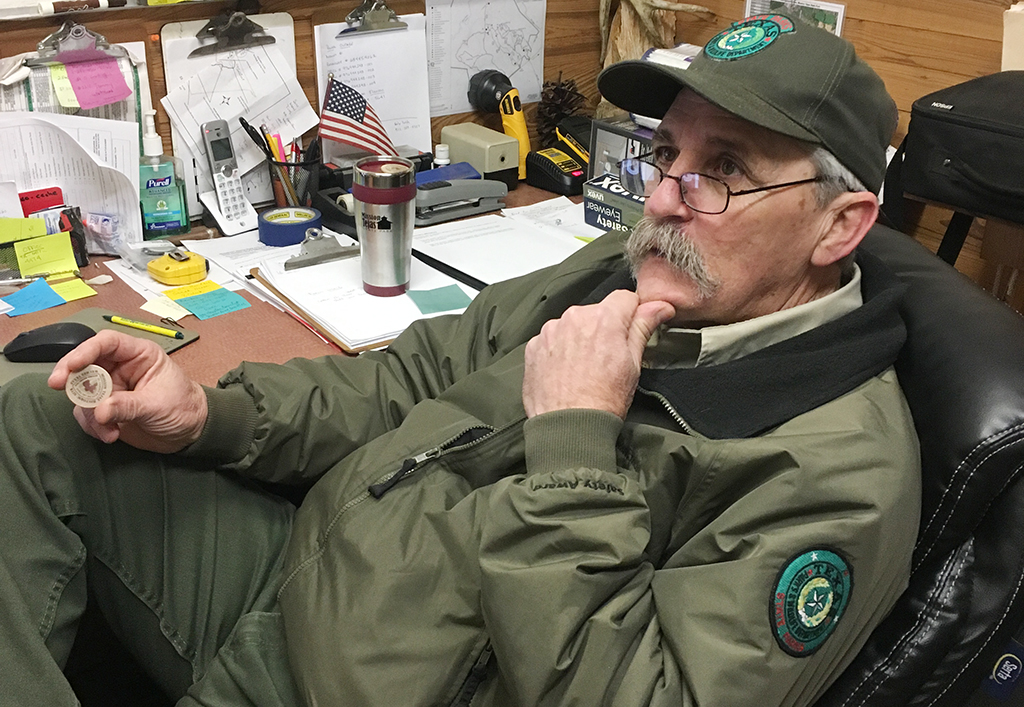
By Sarah Naron
Messenger Reporter
WECHES – Nestled beneath towering loblolly pines and oak trees just off State Highway 21 in the community of Weches, roughly 17 miles east of Grapeland, lies Mission Tejas State Park, an area rich with Texas history which offers activities such as camping, fishing and hiking sure to delight outdoor enthusiasts young and old.
Among the individuals in charge of caring for the 660-acre park is Nacogdoches resident Kirk LeBlanc, a park ranger and maintenance supervisor who began working for Mission Tejas in October and previously served as a volunteer in the park, logging a total of 530 hours.
“This is fun; I like this a whole lot,” he said of his job. “I volunteered almost every Sunday out here, so that’s how I got to know Texas Parks and Wildlife (TPWD) and realized how big Texas Parks and Wildlife is.”
LeBlanc explained that each day begins with computer work at 7 a.m. On Monday, he was working on putting the final touches on a PowerPoint presentation about the park he will be giving at a ranger conference in Navasota later in the week, where he will also receive further training related to his position.
“We do a lot of training,” he explained. “Texas Parks and Wildlife is all about training. The more training you can get, (the more) opportunities (you can) go to, (and) the more fun it is.”
In addition to the training provided by TPWD, LeBlanc gleaned much of his knowledge through his experience at other employers.
Prior to beginning his position at Mission Tejas, LeBlanc worked as an in-house cabinet builder for a hospital.
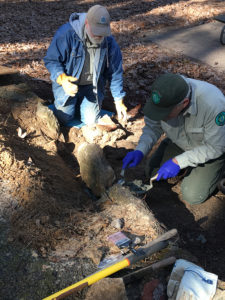
“You wouldn’t think a hospital needed a cabinet builder, but they do,” he said. “Every time they change a piece of equipment, that involves remodeling or rebuilding something to hold that piece of equipment on.”
Following the conclusion of his 17 years as a hospital employee, LeBlanc worked as a maintenance supervisor for an apartment complex for nine years.
“At an apartment complex, you do a little bit of everything – plumbing, electrical, HVAC, anything that has to do with a house; a small home,” he said. “We had 690 units, so that was a lot to keep up with.”
LeBlanc also spent nearly a year maintaining the schools in the Nacogdoches Independent School District.
“That’s what gave me the skills to get this job,” LeBlanc said of his previous work.
LeBlanc’s interest in maintenance work was sparked at an early age.
“When I was growing up in school, my mother was the secretary of my grammar school,” he explained. “So, they would let me fix things. Instead of going to class, I would do maintenance work in the school.
“It was just a love of working with my hands and (being) able to fix things,” he continued. “We came from a family that didn’t have a whole lot, but we fixed what we had – made our own toys and things like that.”
In addition to maintenance, a large part of LeBlanc’s job includes interacting with park visitors.
“Everybody’s usually pretty happy when they come camping,” he said. “So, if you can kind of help them with the history of the park and explain what the El Camino Real is – that kind of stuff – (it just makes) the park experience better.”
Prior to the departure of Park Interpreter Josh Crawford, LeBlanc worked closely with him, calling those in the interpreter position “a valuable asset” to the parks by which they are employed.
“They’re actually trained to educate people about the park,” he said. “By working with him, you can see the enthusiasm of the kids having a good time and exploring the woods and tracking animals.”
LeBlanc explained that he and his wife first met Crawford during a visit to the park one December.
“We decided to go to state parks on Christmas Day,” he said. “So, we came here, and he kind of engaged us and told us about the park. So, we started coming back and forth to the park.”
LeBlanc also works closely with park hosts, of which Mission Tejas currently has three, including Jimmy Harman who, at the time of the interview, was working busily in the maintenance shop on exhaust fans which will be installed in the park bathrooms.
“They go from park to park, and they’ll stay a three-month sequence,” explained LeBlanc. “They can live here for three months or as long as they want, and in turn, they help the rangers and do maintenance work.”
Such individuals, Harman said, are of great importance to Mission Tejas and the other state parks which they serve.
“State parks would be lost without volunteers,” he said, a statement with which LeBlanc quickly agreed. “They couldn’t afford to staff the parks like they need to without volunteers.”
As fellow park host Paul Hamilton explained, a current major goal of the park hosts is to ensure that the park is ready for the influx of visitors expected during spring break.
“Our main focus is to ensure that the guests are comfortable and relaxed and enjoy the environment and make sure that their wants and needs are fulfilled while they stay here,” he said.
“Spring break is a big time for all families,” Hamilton pointed out. “These parks are family-oriented for this.”
According to LeBlanc, the hosts have recently assisted in the completion of replacements of equipment throughout the park.
“We have changed our electrical pedestals out – the uprights where you plug the RV’s in,” explained LeBlanc. “We changed 15 electrical panels out; that’s a major park improvement.”
Also new to the park is a tankless hot water heater.
“Now, you have hot water all the time; you don’t have to wait for a conventional hot water tank,” he said. “That’s a major improvement for Mission Tejas.”
LeBlanc took a few moments to check out the progress made on the construction of the park’s new headquarters, which he anticipates will be “a pretty cool park experience.”
According to LeBlanc, construction on the new facility began approximately one year ago.
“It’s a slow buildup,” said LeBlanc of the process. “The state checks things and checks things. The state builds it in the concept of lasting a long time. So, they’re very, very thorough about checks and rechecks.”
Displayed near the ceiling in what will become the park’s gift shop is a portrait of Company 888 of the Civilian Conservation Corps (CCC), the group which constructed Mission Tejas.
“The CCC, back in the Depression, was trying to put people back to work,” explained LeBlanc. “They formed groups, and they were responsible for going around building parks all over the United States.”
Workers employed by the CCC were paid $1 per day and permitted to keep $5 a month for themselves, while the rest of their earnings had to be sent home.
The building housing the gift shop will also feature offices and facilities for park officials, as well as a library for visitors seeking more information on the El Camino Real, a historic pathway of which an original segment is contained within the park.
“We’re excited about this,” said LeBlanc of the new headquarters. “More space and great for the visitors.”
Next to the new headquarters are bathrooms for use by park guests. The trellis connecting the buildings serves as a means of guiding rainwater into two large tanks for collection. As LeBlanc explained, the water will be used to flush the toilets in the facility, allowing the park to conserve water.
A museum providing visitors with further information on the Texas history surrounding Mission Tejas is also being constructed.
Sauntering back toward the maintenance shop from the new buildings, LeBlanc took in his surroundings.
“It’s a pretty good office,” he said of the park. “I get to see this every day. And I see it all seasons, too.”
LeBlanc said his favorite season to experience in the park is springtime, “when everything turns green.”
When asked to identify the most challenging aspect of his job, LeBlanc cited the repair of underground water leaks.
“It’s a very old park that’s got very old water pipes,” he said. “That’s the most challenging right now.”
Later in the day, LeBlanc pointed out a tree that had fallen in the fishing pond located within the park, explaining that the removal of trees which fall in this area is another challenge experienced on the job.
“If they’re on the ground, you can cut them up, but when they’re in the water, it’s totally different,” he said.
LeBlanc spoke enthusiastically of educating children who visit Mission Tejas during events such as the park’s annual folk festival, which is held the last weekend in April.
“That’s pretty cool,” he said of the event. “We’ll have people dressed up (in costumes from) the early 1800s. I normally dress up myself like a Texas Ranger and teach about when they came on board (and) why we had Texas Rangers.”
LeBlanc enjoys asking the children with whom he interacts during the event how many stars appear on the Texas flag.
“I get all kinds of answers,” he chuckled. “That’s kind of fun.”
Pausing in front of the Rice Family Log Home – which was originally built in 1828, moved to the park in 1974 and believed to be Houston County’s oldest surviving structure – LeBlanc provided an anecdote of his interaction with a visiting Girl Scout group.
“We used to have a little bat that lived in there,” he explained. “I showed them where the bat was, and they said, ‘You need to name it.’ And I said, ‘Well, why don’t y’all name it?’”
The girls, LeBlanc said, originally decided on the name “Alex” until one member of the group questioned how the gender of the bat was known.
“They were going to come up with a generic name,” LeBlanc continued. “So, I said, ‘Why don’t y’all go back to your camp, vote about it and come back the next day and tell me what y’all voted on?’”
After taking the necessary time to ponder the options and cast their votes, the troup returned to LeBlanc with their final decision as to the name of the cabin’s winged resident: Scout.
“That’s the kind of things you do with the kids,” he said. “You know, make it fun for them.”
In addition to interacting with and educating park visitors, LeBlanc is responsible for maintaining the park’s many trails, making sure that adequate signage is up to help visitors find their way around the park and tending to the bridges located throughout the park.
During the fall season, as LeBlanc explained, clearing leaves which have accumulated on the bridges is an important part in preserving the structures.
“That saves the bridges from deteriorating, holding moisture and rotting,” he explained. “That’s one of the behind-the-scene jobs that we do.”
Among the projects completed by LeBlanc and Harman during the workday Monday were refilling holes created while fixing water leaks at sites within the park’s campground. The hole is filled with dirt, which is packed tightly and smoothed over.
LeBlanc and Harman also began the process of repairing the driveway of one of the park’s campsites, which had been damaged due to water erosion. A portion of the small rock border had fallen out of place, and the stones were reattached with cement. After allowing sufficient time for the cement to dry, Harman explained, the next step will involve packing the dip in the driveway with sand before replacing the portion of asphalt which had been damaged.
“It’s really not that challenging or stressful,” said LeBlanc of the job overall. “I’ve been on stressful jobs. The hospital’s kind of stressful; it’s more like life and death there.
“This is more fun to me,” he said of his job at Mission Tejas.
Sarah Naron may be reached via email at [email protected]. If you would like to be featured in a future edition of “A Day in the Life,” contact Sarah by email or by calling The Messenger at 936-687-2424.

